Intro to XRd
Technology state and Market trends
Network Function Virtualization (NFV) has been around for years. The Virtualization exercise which has been started to utilize the compute resources in an efficient way has been adopted by the Network functions to deploy the networks in much more agile & cost-effective manner.
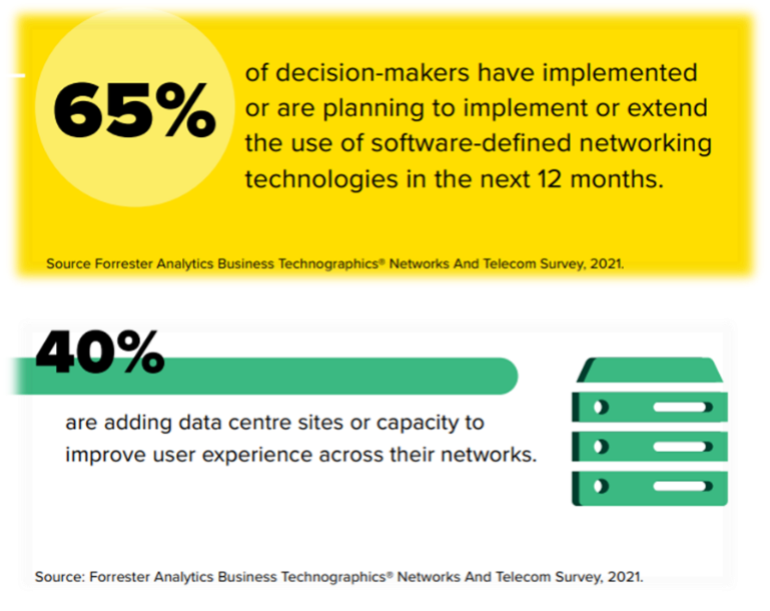 {width=”3.468801399825022in” height=”2.7555555555555555in”}But the virtualization uptick has been slow due to:
{width=”3.468801399825022in” height=”2.7555555555555555in”}But the virtualization uptick has been slow due to:
a) ETSI MANO standards were slow in converging
b) throughput on COTS severs is not enough for some of the Network Place-in-a-Networks (PINs)
c) fragmented deployments in various virtualization environments.
However, with changing traffic consumption patterns by end users (detailed in later sections), Service Providers are preferring the distributed deployments with Software Defined Routing (Figure 1). Kubernetes (K8S) has emerged as de-facto way of deploying containerized applications, bringing in commonality among various environments on how the virtualized resources are presented to the applications and this is one of the key drivers for the Virtual or Cloud Native Network Function adoption.
A recent blog by Johan Gustawsson aptly summarizes the key trends in metro architecture: “Edge computing and the hosting of virtualized network functions, new revenue-creating applications, and localized content drive the intense need for efficient integration into networking”. The blog also talks about “The network edge must become a floating function implementable at any hierarchical layer to facilitate integration with more distributed computing and content hosting.” This trend is not common to Metro architecture but universally applies to entirety of Service Provider Networks. As more content and applications need to be deployed closer to the end user, Service Providers are forced to extend the compute capabilities to at farther points in the network. VNFs play a significant role in connecting & processing of the traffic from the applications and content caches to the Data Centres or public clouds where bulk of application processing is done. Figure 2 details the relevant VNFs, that can be deployed at different Edge locations, how the play of Service Providers and Public Cloud Providers can span across the edge locations in the network.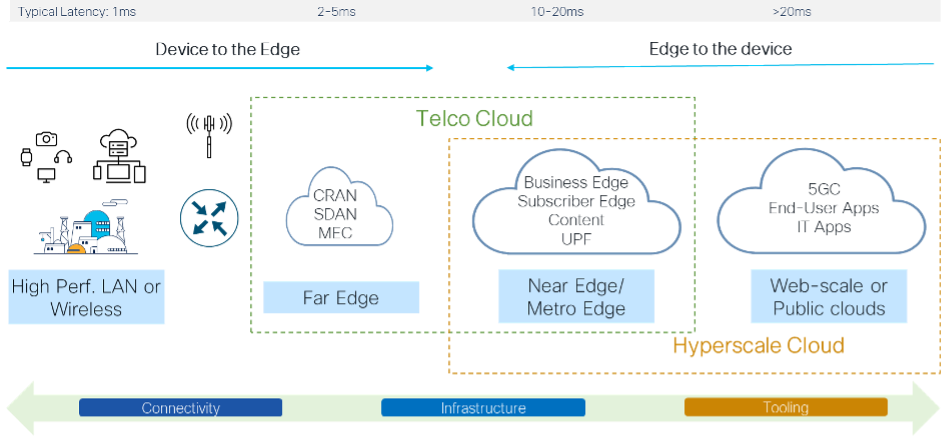 {width=”6.268055555555556in” height=”2.9027777777777777in”}
{width=”6.268055555555556in” height=”2.9027777777777777in”}
Figure 2
Public Cloud Providers (PCPs) are providing solutions to install the infrastructure at on-prem or Edge locations, in order to extend the same tooling and management for the applications that run-in the cloud, providing consistent hybrid cloud experience. In this process, PCPs are partnering with telcos to innovate new ways of connectivity and offer new Value-Added Services to end users. In this partnership, Service Providers benefit from:
a) PCPs’ vast experience in managing virtual and cloud native workloads
b) quicker, on-demand scale-up and scale-down options provided by PCPs.
Figure 3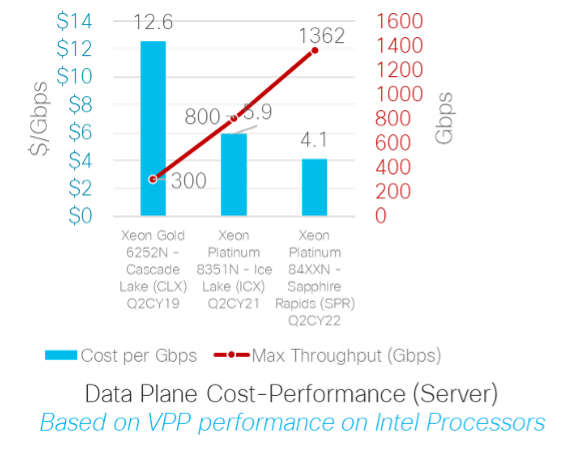 {width=”3.865972222222222in” height=”2.9965277777777777in”} indicates the speed improvements done on Intel x86 CPUs from past few generations. Though the throughput (and Packets Processed per Second – PPS) augmentation does not follow Moore’s law anymore, there is a considerable jump in the throughput numbers, bringing cost per Gbps down. In addition to above, there are considerable improvements in I/O and L2/L3 caches in the newer generation x86 processors. These improvements will remove the bottlenecks and drive more Network Functions to be Virtualized.
{width=”3.865972222222222in” height=”2.9965277777777777in”} indicates the speed improvements done on Intel x86 CPUs from past few generations. Though the throughput (and Packets Processed per Second – PPS) augmentation does not follow Moore’s law anymore, there is a considerable jump in the throughput numbers, bringing cost per Gbps down. In addition to above, there are considerable improvements in I/O and L2/L3 caches in the newer generation x86 processors. These improvements will remove the bottlenecks and drive more Network Functions to be Virtualized.
Containerized XR overview
XRd is the latest containerized Virtual Router offering from Cisco, deployable on the Containerized Infra or Cloud Infra along with other Virtual or Cloud Network Functions and applications.
XRd complements the Physical routers, in Virtual or Cloud environments, to provide an end-to-end ubiquitous XR experience. All the programmability aspects (NETCONF and YANG models) are inherited from IOS-XR to XRd, which allows operators to reuse the same automation and orchestration systems, presenting seamless visualization and management of XR devices, physical or virtual, deployed on-prem cloud or public cloud. XRd comes with support for low footprint optimization and can run with as low as 2 CPUs.
XRd is being offered in two flavours:
Control plane (with minimal forwarding plane functionality) which is used for signalling heavy applications like Route reflector, SR-PCE.
vRouter (Control plane and the Forwarding plane bundled) which is suggested for Provider Edge
Apart from legacy/traditional use cases of Virtual Route Reflector (vRR), Path Controller Element (PCE), Virtual Provider Edge (vPE) and lab simulation, XRd brings in support for new use cases such as Virtual Cell Site Router (vCSR) and Cloud Router Gateway.
XRd can be deployed as Virtual Cell Site Router (vCSR) with very low footprint sharing the compute environment with Virtual DU (vDU), without a need for dedicated Cell Site Router (Figure 3). With 2 vCPUs, vCSR can crank up to 30Gbps (depends on actual CPU & average packet size). Since vDU is a CPU hungry application, the low footprint of XRd helps remove the need for installing a dedicated router at the sites which do not need massive MIMO scale throughputs and have limited power & space. For those sites, physical cell site router like NCS5xx is needed to satisfy the port count needed for Front haul (detailed in Figure 4 below).
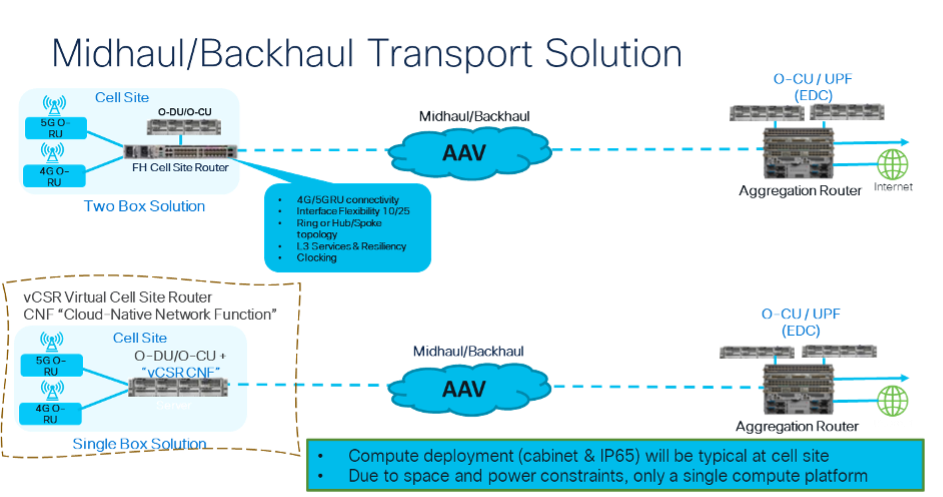 {width=”6.268055555555556in” height=”3.2954735345581803in”}
{width=”6.268055555555556in” height=”3.2954735345581803in”}
Figure 4
XRd as a containerized application can run on Public Cloud Infra and can be deployed as Cloud Router Gateway (Figure 5), enabling taking the on-prem transport protocols into the public cloud. This allows operators to extend their existing monitoring and assurance systems to the Network Functions, deployed in the public cloud, providing unified XR experience. XRd provides an efficient overlay solution masking some of the limitations of the Public Cloud Infra, which does not support broadcast & multicast capabilities which inhibit running traditional IGP protocols. XRd Cloud router provides the overlay solution, to uplift the transmission of traditional SP protocol packets via the GRE tunnels to the VPCs in the public cloud. With this overlay solution, Service providers can seamlessly manage the telco applications and routing instances across the existing network and public cloud, using the current automation and assurance systems. Currently the Cloud Router solution is being tested by one of the largest green field mobile operator networks in US, where the 5G Packet core is deployed in AWS and Cloud Router acts as gateway for the 5GC applications. In future, once the support for IPv6 underlay comes from PCP, SRv6 to avoid complexity of various layers inside GRE tunnels.
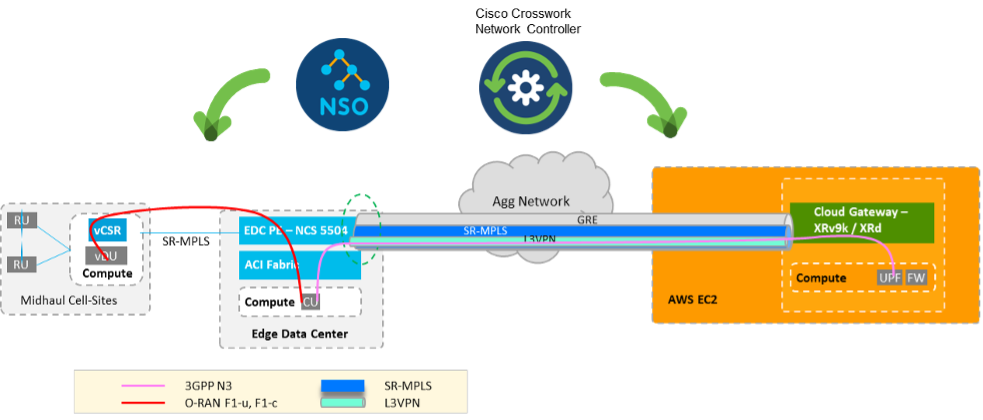 {width=”6.530555555555556in” height=”2.7893383639545055in”}
{width=”6.530555555555556in” height=”2.7893383639545055in”}
Figure 5
As the cloud computing capabilities extend to the Far Edge, XRd can play an increased role either for on-ramping traffic to CDNs, Caches or to act as a gateway for Distributed Public Cloud locations (e.g., Amazon Outposts).
Summary and call for action
With release 781, XRd is qualified for vanilla K8S and Amazon EKS environments. Helm chart support has been added as part of the current 781 release, making it easily deployable in various Cloud Infra environments. ENA NICs are supported for XRd. Earlier release of 771 (FCS for XRd), supports docker deployment for lab evaluation. Intel E810 and 700 series are available for evaluation, though official support is pending.
Relevant cloud formation templates for the EKS deployment are available in the public GitHub page of XRd. Currently the team is working with other Cloud Infra providers to qualify XRd in other host environments.
More technical details on the XRd deployment, are documented in tutorial sections of XRdocs. XRd is available for 90-day trial from CCO. Please go ahead and spin up few XRd instances in your lab and send feedback to us!
Leave a Comment